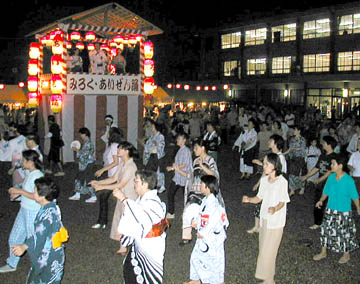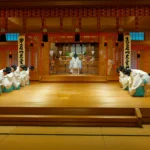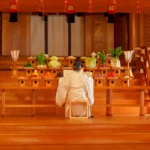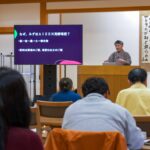By Ruth Reiner
Dear friends, I am happy to say that I have survived my four week Summer Intensive course in Japanese. It was actually a pretty good course. Can I speak Japanese now? Well, that I am leaving for your free imagination!
Well, hope you are all surviving the summer heat. I must tell you it really is sticky here in the summer: it is not only the stories about the Kyoto area are true! But the nights are relatively cool. I am actually having lately the time of my life with all the summer festivals. I am a festival freak, and a lot of festivals are going on these days here in Japan.

Well Oomoto actually has Bon dances for some two weeks now in the summer, every evening, as rehearsals for the big summer festival. As the night falls, people slip into their traditional Japanese summer kimonos called Yukata and gather outdoors for the dance. The Bon dances are traditional joyful Japanese style dances that are danced to the sound of cheerful melodies. Most of the words in the Oomoto dances were written by Onisaburo actually! and sung to the same melodies. On a high stage in the center of the dance circle, people sing to the light of the beautiful Japanese lanterns, and to the beat of the huge Taiko – drum!
Well I’ve got to get back to our actual story… Last time Onisaburo was on his way to Mongolia. I must say honestly that the following chapters about the voyage in Mongolia, I’ve found quite hard to summarize. Since it gives a great deal of historical background, and deals with many new acquaintances Onisaburo made through his voyage. But I would like to mention a few points:
I guess what is said in chapter 23 can give a kind of idea how Onisaburo related to his journey years later:
“My first goal in going to Mongolia was the spiritual and religious unity of the world, and my second was to make a contribution to world peace in the face of the philosophical stupor and international unrest of those days.”
My impression from my maybe limited understanding, is that Onisaburo had this dream or vision to start or found some spiritual and religious unity in the world that would help forward world peace. I personally think it is a beautiful idea. But I must say that the descriptions in these chapters of those years, in the vast lands, and the arrival of a foreigner, had a magical touch of mystery. Some of the tales described in these chapters can sound quite naive.
With his incredible charisma, it only sounds natural that some would see Onisaburo as more than a regular human being. There are also some descriptions of healing he has performed, and how he could influence the weather, things that have convinced more and more people of his unique powers.
About influencing the weather. Actually some months ago someone here in Oomoto had mentioned to me that influencing the weather is said to be one of the less difficult things to do… well I can’t argue much about that… but I just want to note an anecdote: I have been here about 8 months now. Oomoto being a Shinto sect, has ceremonies relating to the changes in seasons… In February Oomoto holds one of the most beautiful festivals I’ve ever attended in this life time. It’s called Setsubun, It is a purifying ceremony, held in the town of Ayabe (remember from the earlier chapters). Anyway it takes place on a white night, when all the town is covered by snow.
Being an Israeli, I had not experienced many snowy winters. I was very excited as the days were coming closer to the grand festival. But actually the weather was not very promising (for snow). The morning of Setsubun I headed off with a dear friend to the town of Ayabe. On the way there the snow was falling slowly covering the woods that ran on both sides of the train tracks to Ayabe. Upon arrival we stopped at a coffee shop to warm up. Sitting there we asked a kind old lady, in our amateur Japanese toungue: “When did the snow begin?” She answered, “this morning.” By night time as the ceremony began, the whiteness of the snow reflected as the light of a new born baby. Since that day I’ve realized how every seasonal festival held here is accompanied in beautiful harmony with it’s promised weather.
Oh yeah but here I go off again from our main story, sorry…. Anyway I would also like to add that there is another reason I found it very hard to deal with the chapters about the voyage to Mongolia. Of course this is my opinion, but it seemed to me that there was also somewhat of a gap between the words of Onisaburo and the actual means. The issue of Onisaburo’s doings in Mongolia is known among the Oomoto members themselves as an enigma. For me one thing that sounded quite strange, was the feeling I got that Onisaburo was trying to make believers.
Today it is very much emphasized here in Oomoto, that Oomoto does not try to make believers, but to act as a model, dealing with self improvement from the inside, and so that would be the only way they may influence others. In Onisaburo’s voyages it seemed rather a different approach, for instance among other things, Onisaburo had adopted as his name the name of The Dalai Lama Buddha Maitreya and Suzun Khan. These things made me a bit confused and a bit uncomfortable. Trying to consult with others I found that I was not the only one with big question marks. Actually that was something that impressed me a lot, the openness of some of the believers to have doubts or questions about specific things, important in my view in any religion.
Well thanks for coming back to read my articles, we will continue this discussion of doubts and feelings next time. So stick in there…



